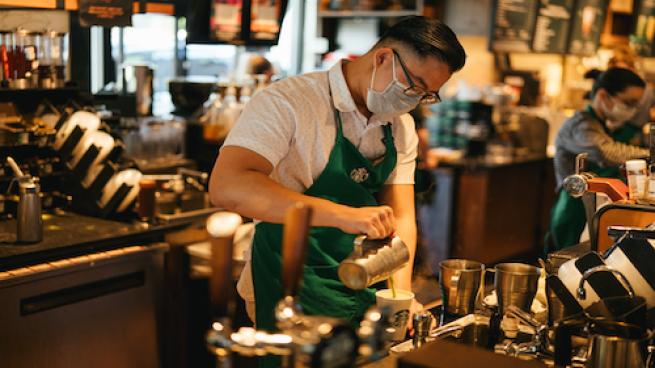
As Starbucks goes, so goes retail?
Well, maybe not, but the Seattle-based chain’s latest quarterly financial report offers some reason for optimism about commerce, and some ideas about what might come next.
Indeed, the company’s results for its fiscal third quarter highlight the importance of having robust loyalty and digital programs as the pandemic continues. In discussing those results, Starbucks CEO Kevin Johnson also shed light on what the future will bring for the company’s in-store retail efforts.
Digital Gains
When the chain’s fiscal third quarter ended on June 28, 96% of its U.S. stores had reopened after pandemic closings, up from 44% at the quarter’s start.
“Through a combination of new store-operating protocols and service channels, we were able to amplify a number of contactless experiences for our customers, including drive-through, entryway pickup with mobile order and pay, and delivery,” Johnson told analysts on the post-earnings conference call. “Today, customers are seeking safe, familiar and convenient experiences in many aspects of their lives. And in that regard, our digital assets have proven to be a competitive advantage.”
Among the main advantages from the retailer's point of view is its influential Starbucks Rewards loyalty program, which added 3 million members in the fiscal third quarter, a 17% gain from Q2. Starbucks had previously revealed an upcoming expansion of its influential Starbucks Rewards loyalty program, which could bring more growth by the end of the year.
Mobile ordering — a hot trend before the pandemic for food and beverage sellers — also showed fresh strength for Starbucks in Q3. Customer use of the chain’s mobile ordering tool accounted for 22% of all transactions in Q3, up six percentage points from Q2.
Consumer Shifts
The time and types of orders placed by Starbucks customers continue to shift, reflecting the broader realities of the pandemic.
“We continue to see improvements in the morning peak period as well as some customer occasions shifting to later in the morning daypart,” Johnson said. “As we see customer visits shifting from urban cafes to suburban drive-thrus, customers are also purchasing multiple beverages and food items on a single order, essentially a group order.”
Overall, the company posted a 38% year-over-year decline in revenue, to $4.2 billion, with global comparable-store sales down 40%, declines blamed largely on the pandemic.
About 90% of sales during the fiscal third quarter came via mobile and drive-thru orders. Further, orders placed via the Starbucks Delivers service “tripled in Q3 from Q2 levels, with the highest volume in the late morning and midday,” Johnson said. “All of this indicates that customers are adapting their routines, and we are well positioned to drive further recovery by simply increasing throughput and enhancing those safe, familiar and convenient experiences customers desire.”
At-Home Coffee
Demand for Starbucks at-home coffee products also “soared” during Q3, Johnson said. More specifically, the Starbucks share of the U.S. packaged coffee market grew 21% in Q3 when measured by spending, and the company’s domestic ready-to-drink business increased by 11%.
“Our Global Coffee Alliance with Nestlé, combined with our ready-to-drink partners, including PepsiCo and Tingyi, have extended our ability to meet customers where they are, which is particularly important in the current environment,” Johnson said. “We are now in 53 markets with the Global Coffee Alliance, more than tripling our at-home coffee presence versus a year ago. And we expect to be in over 60 markets by the end of this fiscal year.”
Future Stores
As that aspect of the business grows, Starbucks is also mapping out the future of its stores and preparing for whatever the new normal might be after the pandemic subsides. That future, Johnson said, will include building Starbucks Pickup stores in urban areas that are not suitable for drive-thrus and curbside deliveries.
“These stores are built in a smaller footprint and create a familiar and convenient walk-thru experience that is very relevant to customers in urban markets,” he said. “Each of these Starbucks Pickup stores will ideally be located within a three-minute to five-minute walk from a traditional Starbucks store, giving customers the flexibility to enjoy their beverage in our store or on the go.”
Starbucks plans to build at least 50 such stores within the next 18 months, and have “several hundred” of them in the United States within three to five years, according to Johnson. Starbucks is rolling out a similar concept in China, and no doubt the lessons learned there — and the lessons learned so far during the pandemic — will do much to guide the future of the chain and influence other retailers.
"loyalty" - Google News
July 30, 2020 at 02:35AM
https://ift.tt/2CTasae
Starbucks Makes Loyalty Gains and Maps its Future - Retail Leader
"loyalty" - Google News
https://ift.tt/2VYbPLn
https://ift.tt/3bZVhYX
Bagikan Berita Ini














0 Response to "Starbucks Makes Loyalty Gains and Maps its Future - Retail Leader"
Post a Comment